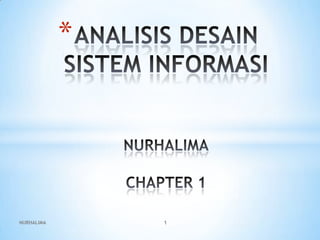
Pert.1 pengenalan analisis desain
- 1. * NURHALIMA 1
- 2. * Define information systems analysis and design Discuss the modern approach to systems analysis and design Describe the organizational roles involved in information systems development NURHALIMA 2
- 3. * Describe four types of information systems: Transaction Processing Systems (TPS) Management Information Systems (MIS) Decision Support Systems (DSS) Expert Systems (ES) Describe the information systems development life cycle (SDLC) NURHALIMA 3
- 4. * Discuss alternatives to the systems development life cycle Discuss the role of computer-aided software engineering (CASE) tools in systems development NURHALIMA 4
- 5. * * Information Systems Analysis and Design * Complex process whereby computer-based information systems are developed and maintained * Application Software * Result of systems analysis and design * Designed to support specific organizational functions or processes NURHALIMA 5
- 6. * *Software engineering processes have been developed to assist in analysis and design * Methodologies * Comprehensive, multi-step approaches to systems development * Techniques * Processes that are followed to ensure that work is well thought-out, complete and comprehensible to others on the project team * Tools * Computer programs to assist in application of techniques to the analysis and design process NURHALIMA 6
- 7. * *Information Systems Analysis and Design * A method used by companies to create and maintain systems that perform basic business functions * Main goal is to improve employee efficiency by applying software solutions to key business tasks * A structured approach must be used in order to ensure success NURHALIMA 7
- 8. * * Systems Analyst performs analysis and design based upon: * Understanding of organization’s objectives, structure and processes * Knowledge of how to exploit information technology for advantage NURHALIMA 8
- 9. * *A process used to create an information system *Consists of: * Methodologies * A sequence of step-by-step approaches that help develop the information system * Techniques * Processes that the analyst follows to ensure thorough, complete and comprehensive analysis and design * Tools * Computer programs that aid in applying techniques NURHALIMA 9
- 10. * * Three key components of an information system * Data * Data Flows * Processing Logic * Data vs. Information * Data * Raw facts * Information * Derived from data * Organized in a manner that humans can understand. NURHALIMA 10
- 11. Data and Processes * NURHALIMA 11
- 12. * * Data Flows (Continued) * Include description of sources and destination for each data flow * Processing Logic * Describe steps that transform data and events that trigger the steps NURHALIMA 12
- 13. * *Process-Oriented Approach * Focus is on flow, use and transformation of data in an information system * Involves creating graphical representations such as data flow diagrams and charts * Data are tracked from sources, through intermediate steps and to final destinations * Natural structure of data is not specified * Disadvantage: data files are tied to specific applications NURHALIMA 13
- 14. * *Database * Shared collection of logically related data * Organized to facilitate capture, storage and retrieval by multiple users * Centrally managed * Designed around subjects * Customers * Suppliers *Application Independence * Separation of data and definition of data from applications NURHALIMA 14
- 15. * * Systems Analysts work in teams * Project Based * Includes * IS Manager * Programmers * Users * Other specialists * Characteristics of Successful Teams * Diversity of backgrounds * Tolerance of diversity * Clear and complete communication * Trust * Mutual Respect * Reward structure that promotes shared responsibility NURHALIMA 15
- 16. * *Transaction Processing Systems (TPS) * Automate handling of data about business activities (transactions) *Management Information Systems (MIS) * Converts raw data from transaction processing system into meaningful form *Decision Support Systems (DSS) * Designed to help decision makers * Provides interactive environment for decision making NURHALIMA 16
- 17. * * System Development Methodology * Standard process followed in an organization * Consists of: * Analysis * Design * Implementation * Maintenance * System Development Methodology * Standard process followed in an organization * Consists of: * Analysis * Design * Implementation * Maintenance NURHALIMA 17
- 18. * * Project Identification and Selection * Two Main Activities * Identification of need * Prioritization and translation of need into a development schedule * Helps organization to determine whether or not resources should be dedicated to a project. * Project Initiation and Planning * Two Activities * Formal preliminary investigation of the problem at hand * Presentation of reasons why system should or should not be developed by the organization NURHALIMA 18
- 19. * * Analysis * Study of current procedures and information systems * Determine requirements * Study current system * Structure requirements and eliminate redundancies * Generate alternative designs * Compare alternatives * Recommend best alternative NURHALIMA 19
- 20. * *Prototyping * Building a scaled-down working version of the system * Advantages: * Users are involved in design * Captures requirements in concrete form *Rapid Application Development (RAD) * Utilizes prototyping to delay producing system design until after user requirements are clear NURHALIMA 20
- 21. * * Information systems analysis and design * Process of developing and maintaining an information system * Modern approach to systems analysis * Process-Oriented * Data-Oriented NURHALIMA 21
